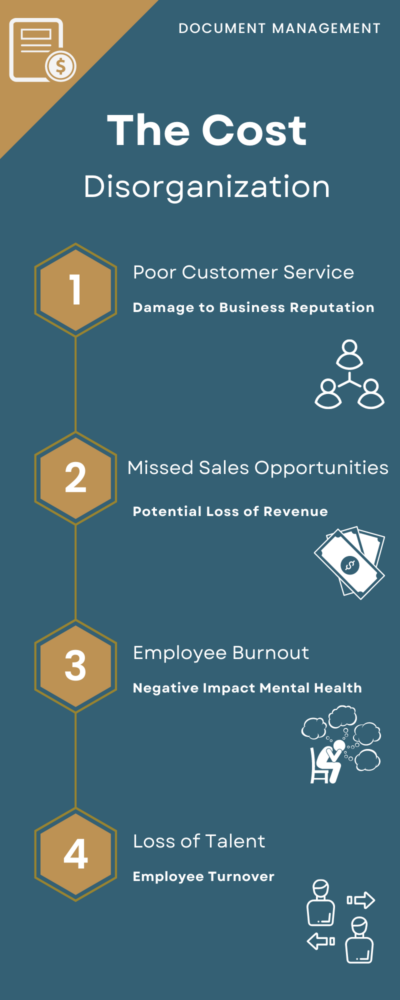In today’s digitally dependent and data-driven world, a well-managed document management system is an absolute must for any organization. Digital document management systems are designed to help people work more efficiently by streamlining processes, improving data management, optimizing business communication, and increasing productivity. If implemented correctly, it benefits both employees and customers.
The reality is that it’s complicated and there are a lot of moving pieces involved. Whether it’s data entry, editing, sharing, storing, archiving, or a combination of these things, document management can be overwhelming.
If you’re not the most tech-savvy person, staying on top of all the system pieces can be challenging; it’s easy for things to go wrong. As organizations and companies make the transition to digital document management for the first time or they’re in the process of trying to find a better fit for their business needs, they’re bound to experience some pain points along the way.
In this post we’ll discuss the top three pain points of digital document management and provide some tips to help you address them.
Why Digitization Matters
Without a document management system successfully implemented within your organization, your company may struggle to execute digital transformation initiatives. Why does this matter?
According to the MuleSoft 2022 Connectivity Benchmark Report, which includes interviews from over 1,000 global IT leaders, “70% of organizations fail to provide completely connected user experiences.”
Digital document management systems are an important key to digital transformation. It helps create the path for business to provide connected user experiences, which are valuable to both employees and customers.
Let’s discuss how you can avoid the headaches and pain points of digital document management and clear the pathway to successful implementation.
Pain Point #1: Keeping Track Of Everything
Keeping track of everything can be extremely frustrating. If your organization doesn’t have the proper document management system, your work can feel pretty daunting; trying to find a specific document when you need it can feel like looking for a needle in a haystack. Next thing you know, you’re looking at your watch as panic sets in, and you try to catch up for lost time.
In a survey, Definitive Guide to America’s Most Broken Processes conducted by Nintex, employees reported:
- 49% said they have trouble locating documents
- 43% have trouble with document approval requests and document sharing
When employees aren’t able to do their job and have difficulty with basic tasks like finding and sharing a document, it’s not exactly a roadmap for success for anyone. How does this impact your bottom line?
According to Inc. employees waste an average of 4.3 hrs a week looking for things they have but are unable to find. You may find this data alarming especially when you consider the financial consequences of how your employees’ productivity directly impacts your organization’s overall performance and revenue each year.
Let’s put this into perspective and look at an example of what it can potentially cost a company:
One employee who is paid $25 hr, who loses 4.3 hours per week over the course of 52 weeks a year… results in a potential loss of $5,590.
What’s the solution? Look for a system that enables you to securely store and easily access all your documents and data in one place. This will help you to alleviate the stress and wasted time previously spent trying to keep track of everything. You will also improve accuracy and boost productivity by streamlining your processes. Your employees can then allocate their time more effectively and optimize their workday by not losing valuable time each week searching for documents.
Staying Organized
Without a proper system to manage your digital documents, keeping everything organized may become a serious struggle. Disorganization impacts your company on multiple levels:
- Creates unnecessary tasks and complicates workflows
- Causes confusion for employees with inefficient processes
- Prevents collaboration across departments
- Delays progress when results aren’t delivered
When it comes to digital document management, look for a system that provides the digital solutions your company needs to be organized and to optimize performance. Make sure that you have selected one that offers the right tools which enable you to accurately capture, share, track, and store your digital documents. It should also provide the mobility and secured access your employees will need to do their jobs effectively.
The Cost Of Poorly Managed Document Systems
When documents aren’t properly managed, it’s difficult to be organized, which ultimately makes it harder for employees to keep track of everything and to be efficient in their roles. Both time and resources are wasted. This snowball effect then has an adverse impact on your company’s productivity, performance, and revenue. Another important thing to consider are the intangible costs to an organization like the following:

Pain Point #2: Adapting To Change With Digital Document Management
When most people think of change, especially within the workplace, it probably doesn’t spark joy or excitement. Change can be hard for anyone. However, we all know it’s inevitable and resisting typically only makes it more difficult. Employee pushback can quickly delay progress and derail your success when it comes to things like digital document management.
Whether your organization is implementing a new digital document management system company-wide or making the digital transition for the first time, change is a part of the process.
In order to avoid the pain points caused by employees’ pushback and resistance to change, it’s crucial to address it.
Have a plan outlining the solutions that your company will utilize for change management, which will hopefully help them to be more adaptable.
Culture Is Key: Helping Employees With Change
How do you support employees and help them to adapt to change? Culture is key.
It starts with cultivating a positive culture that fosters collaboration while empowering and supporting employees. Remember, to keep their focus on the benefits and positive outcomes that result from “change.” When it comes to digital document management, help your employees to see both the value and positive impact it will have on their work. For example, highlight key features like improving work life balance and enhancing mobility.

Pain Point #3: Supporting Your Remote Workers
Since the onset of Covid, there’s been a significant shift in remote work trends and expectations. By the end of 2022, it’s forecasted that 25% of all professional jobs in North America will be remote. What does this mean?
The paradigm shift in how and where workers conduct their jobs has created an urgency for companies to adapt in order to meet the needs and demands of today’s workforce. Organizations must be prepared for digitization, which is why it’s so important to have a digital document system that delivers all the features and mobile solutions your remote/hybrid workers will need to perform.
Everything from writing the document to searching, editing, saving, sharing, and converting into various formats should all be done easily within the system.
If you don’t have a digital document management system that is able to support your remote workers, it’s time to look for a better fit. Mobile platforms, secured access, and collaborative tools are a MUST. Keep in mind, they’ll need flexible solutions as they perform their jobs outside the office. Look for a system that enhances mobility with secured connectivity through approved devices, which will also protect your company’s sensitive information and data.
Helpful Tips: Digital Document Management Systems
Ensure your digital document management system is the best fit for all your business needs and objectives. Here’s an overview of key things to look for:
- Improves access and productivity with mobile platforms
- Provides security measures with tools that enable you to control who has access to the system and when
- Offers features like a tracking system to help monitor changes to documents and provide sources
- Increase efficiency by streamlining and organizing all document management processes
- Delivers the support and tools that remote works need in order to be productive and to optimize performance
Next Steps
Reach out to us today! Click the “Get Your Quote” button below, fill out the form, and we’ll quickly reply to you to discuss your project.
Further Reading
Check out some other articles about digital document management:
“5 Biggest Pain Points of Physical Document Management” describes the five biggest pain points of physical document management and provides you with some solutions to alleviate these challenges.
“Legacy Data Migration” defines legacy data, discusses why you (may) need migration to a new system, and the steps involved in a migration/conversion project.
“What Are The Advantages Of Digitization?” provides insights into the advantages of digitization, such as increasing efficiency and modernizing your organization.

